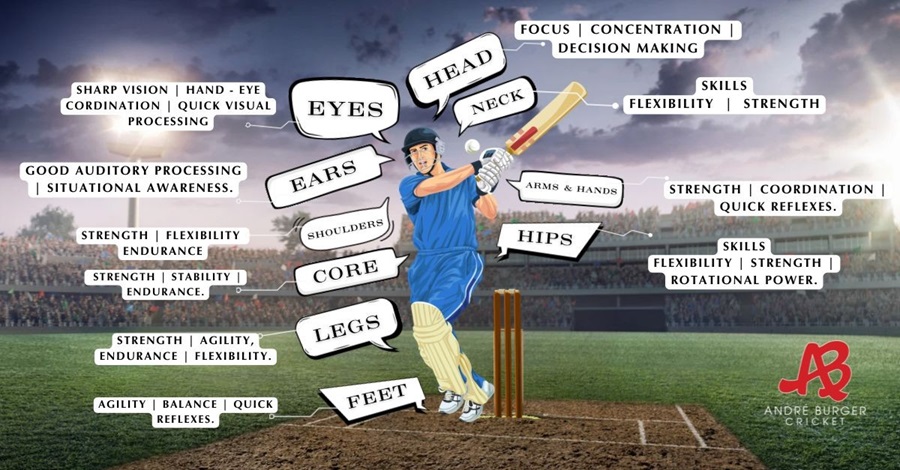The Neuro Batting Program: Strengthening Batters from Head to Toe
Andre Burger | June 29, 2024

In cricket, the ability to perform under pressure is paramount. Whether you're a budding youth player or an experienced professional, the link between physical readiness and mental ability is undeniable. The Neuro Batting Program recognises that to achieve peak performance, every link in the chain must be strong. While vision, cognitive, and mental skills are crucial, the physical attributes from the shoulders to the toes play an equally vital role.
By focusing on holistic development, the program ensures that no part of the batter's performance is left to chance, preparing them to handle pressure and excel in every game. Remember, a chain is only as strong as its weakest link, and the Neuro Batting Program ensures that every link is strengthened for success.
When these physical components are underdeveloped, they can severely impact a player's mental, vision, and cognitive skills, especially under pressure.
Mental Skills
1. Focus and Concentration:
a. Importance: Maintains attention on the ball and game plan.
b. Link: Helps in making quick decisions and maintaining consistency.
2. Decision-Making:
a. Importance: Ensures appropriate shot selection and tactical awareness.
b. Link: Reduces errors and increases scoring opportunities.
3. Visualisation:
a. Importance: Enhances mental rehearsal of techniques and scenarios.
b. Link: Prepares the mind for actual performance, boosting confidence.
4. Emotional Regulation:
a. Importance: Manages stress and pressure effectively.
b. Link: Maintains calmness and clarity under pressure, preventing negative emotions from affecting performance.
5. Confidence:
a. Importance: Belief in one's abilities enhances performance.
b. Link: Encourages positive thinking and resilience in challenging situations.
Physical Skills
1. Hand-Eye Coordination:
a. Importance: Essential for timing and accuracy in striking the ball.
b. Link: Directly affects the ability to hit the ball cleanly and consistently.
2. Balance and Stability:
a. Importance: Ensures a solid batting stance and smooth movement.
b. Link: Allows for controlled and powerful shots.
3. Agility:
a. Importance: Quick footwork to adjust to different deliveries.
b. Link: Enables better positioning and reaction to various types of balls.
4. Strength and Power:
a. Importance: Generates power in shots and enhances endurance.
b. Link: Contributes to hitting boundaries and maintaining performance throughout the game.
5. Flexibility:
a. Importance: Prevents injuries and allows a full range of motion.
b. Link: Ensures longevity in the game and fluid movements.
6. Endurance:
a. Importance: Sustains performance over long periods.
b. Link: Reduces fatigue, maintaining high levels of concentration and physical ability.
Technical Skills
1. Batting Technique:
a. Importance: Ensures correct form and execution of shots.
b. Link: Enhances efficiency and effectiveness in playing different types of deliveries.
2. Shot Selection:
a. Importance: Choosing the right shot for the right delivery.
b. Link: Reduces the risk of getting out and increases scoring opportunities.
3. Running Between Wickets:
a. Importance: Maximises scoring and puts pressure on the fielding team.
b. Link: Improves teamwork and game strategy execution.
Emotional Skills
1. Resilience:
a. Importance: Bouncing back from setbacks and failures.
b. Link: Maintains a positive mindset and continuous improvement.
2. Composure:
a. Importance: Staying calm and composed under pressure.
b. Link: Allows for clear thinking and better decision-making in high-pressure situations.
3. Motivation:
a. Importance: Drives effort and persistence.
b. Link: Sustains long-term commitment and performance levels.
Social Skills
1. Teamwork:
a. Importance: Collaborating with teammates effectively.
b. Link: Enhances overall team performance and support.
2. Communication:
a. Importance: Clear communication with partners and coaches.
b. Link: Ensures everyone is on the same page and can execute plans effectively.
These skills and traits are interlinked, creating a holistic approach that enables youth and experienced batters to perform consistently under pressure. Good physical fitness supports mental focus, while emotional regulation enhances decision-making. Together, they form a comprehensive foundation for success in cricket.
By ensuring each body part is well-prepared and functioning optimally, a youth batter and experienced batter can perform consistently under pressure, adapting to various forms of stress and challenges encountered during the game.
Integration of Skills and Traits
· Mental Preparation: Incorporates focus, visualization, and confidence to prepare for game scenarios.
· Physical Fitness: Ensures that the batter has the endurance, strength, and flexibility to perform consistently.
· Technical Mastery: Combines physical attributes with technical skills to execute batting techniques efficiently.
· Emotional Control: Maintains composure and resilience to handle pressure and setbacks.
· Social Interaction: Effective communication and teamwork enhance strategic implementation and support.
Head
1. Brain:
a. Needs: Cognitive sharpness, focus, quick decision-making, and mental resilience.
b. Function: Processes information rapidly, makes strategic decisions, and maintains concentration.
2. Eyes:
a. Needs: Sharp vision, excellent hand-eye coordination, and quick visual processing.
b. Function: Tracks the ball accurately, allows for quick reactions to different deliveries, and maintains focus.
3. Ears:
a. Needs: Good auditory processing and situational awareness.
b. Function: Processes auditory cues from the environment, such as calls from teammates and instructions from the coach.
Neck and Shoulders
1. Neck:
a. Needs: Flexibility and strength.
b. Function: Maintains a stable and relaxed head position, and allows for smooth head movements to track the ball.
2. Shoulders:
a. Needs: Strength, flexibility, and endurance.
b. Function: Supports powerful and controlled batting strokes, and enables a wide range of motion.
Arms and Hands
1. Arms:
a. Needs: Strength, coordination, and endurance.
b. Function: Generates power in shots, supports bat control, and sustains prolonged periods of batting.
2. Hands and Wrists:
a. Needs: Grip strength, flexibility, and quick reflexes.
b. Function: Maintains a firm grip on the bat, allows for precise shot control, and enables quick adjustments.
Core
1. Core Muscles:
a. Needs: Strength, stability, and endurance.
b. Function: Provides balance and stability, supports powerful shots, and maintains posture.
Hips
1. Hips:
c. Needs: Flexibility, strength, and rotational power.
d. Function: Supports quick footwork, generates power through rotation, and maintains balance.
Legs and Feet
1. Legs:
a. Needs: Strength, agility, endurance, and flexibility.
b. Function: Enables quick and agile movements, supports a stable stance, and provides power for running between wickets.
2. Knees:
a. Needs: Stability, flexibility, and strength.
b. Function: Allows for bending and quick movements, supports balance and agility.
3. Feet:
a. Needs: Agility, balance, and quick reflexes.
b. Function: Enables quick footwork, supports stable and dynamic movements, and allows for rapid changes in direction.
Overall Integration
· Coordination and Balance: Ensures that all body parts work harmoniously to maintain stability and control.
· Endurance and Strength: Sustains prolonged periods of performance, supports powerful shots, and maintains physical resilience.
· Flexibility and Agility: Allows for quick adjustments, smooth movements, and reduces the risk of injuries.
· Mental Focus and Resilience: Maintains concentration, quick decision-making, and emotional stability under pressure.
The Neuro Batting Program is designed to enhance the holistic development of cricketers, ensuring that every part of their body, from head to toe, is primed for peak performance. When these physical components are underdeveloped, they can severely impact a player's mental, vision, and cognitive skills, especially under pressure.
By focusing on developing each body part and addressing potential weaknesses, a youth or experienced batter can create a strong, interconnected foundation that enhances overall performance and resilience under pressure.
Impact of Weakness in Specific Areas
· Weak Brain Function: This leads to poor decision-making, lack of focus, and mental fatigue, resulting in mistakes and inconsistency.
· Weak Vision: Results in inaccurate ball tracking, delayed reactions, and missed opportunities.
· Poor Auditory Processing: Causes missed cues, poor communication, and reduced situational awareness.
· Weak Neck and Shoulders: Limits head movement, reduces shot power, and increases injury risk.
· Weak Arms and Hands: Leads to reduced power, poor control, and slow reactions.
· Weak Core: Causes poor balance, reduced power, and instability.
· Weak Hips: Limits footwork, reduces shot power, and causes poor balance.
· Weak Legs and Feet: Results in slow movements, poor stability, and reduced endurance.
· Weak Coordination and Balance: Causes inefficient movements and increased errors.
· Weak Endurance and Strength: This leads to fatigue, decreased power, and poor performance.
· Weak Flexibility and Agility: Limits range of motion, slows adjustments and increases injury risk.
· Weak Mental Focus and Resilience: Results in poor concentration, inability to handle pressure, and inconsistent performance.
The Importance of Physical Readiness
1. Toes and Feet:
a. Impact of Weakness: Poor footwork and stability
b. Mental Impact: Lack of confidence in movement, leading to hesitation and second-guessing
c. Vision Impact: Difficulty maintaining focus on the ball while adjusting feet
d. Cognitive Impact: Slow decision-making due to unreliable foot positioning
2. Legs:
a. Impact of Weakness: Reduced power and agility
b. Mental Impact: Increased mental fatigue due to compensating for weak legs
c. Vision Impact: Inability to quickly reposition, affecting visual tracking of the ball
d. Cognitive Impact: Poor shot selection under pressure due to lack of mobility
3. Hips:
a. Impact of Weakness: Limited rotational power and flexibility
b. Mental Impact: Frustration from inability to execute powerful shots
c. Vision Impact: Compromised balance affects visual stability
d. Cognitive Impact: Reduced ability to anticipate and react to ball movement
4. Core:
a. Impact of Weakness: Poor balance and stability
b. Mental Impact: Anxiety due to instability, leading to a lack of focus
c. Vision Impact: Difficulty maintaining a steady head position, impacting vision
d. Cognitive Impact: Inconsistent performance due to lack of core support affecting decision-making
5. Arms and Hands:
a. Impact of Weakness: Reduced strength and control
b. Mental Impact: Decreased confidence in shot execution
c. Vision Impact: Struggle to coordinate eye and hand movements
d. Cognitive Impact: Hesitation and delayed reactions due to lack of control
6. Shoulders:
a. Impact of Weakness: Limited range of motion and strength
b. Mental Impact: Increased stress from an inability to perform consistently powerful shots
c. Vision Impact: Compromised follow-through, affecting visual tracking
d. Cognitive Impact: Inefficient energy use, leads to cognitive fatigue
How Physical Weaknesses Impact Mental, Vision, and Cognitive Skills
When a batter's physical attributes are underdeveloped, it creates a ripple effect that undermines their overall performance.
Mental Skills
1. Focus and Concentration:
a. Physical fatigue from weak legs and core can cause a batter’s focus to wane, especially in high-pressure situations. This lack of concentration can lead to poor decision-making and missed opportunities.
2. Confidence:
a. Weak arms and shoulders can make a player doubt their ability to execute strong shots, which erodes confidence. When confidence dips, a batter is more likely to second-guess their decisions and become mentally overwhelmed.
Vision Skills
1. Ball Tracking:
a. Poor footwork and instability from weak toes and feet can make it difficult for a batter to keep their eyes steady on the ball. This visual instability can lead to mistimed shots and an increased risk of getting out.
2. Quick Visual Processing:
a. If a player’s legs and hips are not agile, their ability to quickly reposition and respond to different ball deliveries is compromised. This slows down their visual processing speed, making it harder to react to faster deliveries.
Cognitive Skills
3. Decision-Making:
a. Weak core muscles can lead to poor balance and instability, making it challenging for a batter to quickly and accurately decide on the best shot. This can result in suboptimal shot selection and increased errors under pressure.
4. Mental Resilience:
a. When a player’s physical strength is lacking, they may become mentally fatigued more quickly. This reduces their ability to stay mentally resilient in the face of pressure, leading to increased stress and a higher likelihood of mistakes.
Each player follows a structured and personalised program, if you are interested and willing to do the work contact me at @andre@andreburgercricket.com








